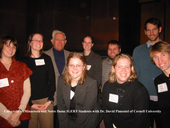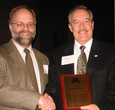Highlight
Symposium: Predicting the Invasive Potential of Exotic Species
Achievement/Results
Our symposium entitled, Predicting the Invasive Potential of Exotic Species, was the key highlight for this reporting cycle. The symposium, funded by the University of Minnesota’s Minnesota Futures program and the NSF sponsored Risk Analysis for Introduced Species and Genotypes IGERT (Integrative Graduate Education and Research Traineeship), met its aim by attracting a world-class, broadly inclusive, group of scientists and policy practitioners to join with the general public, University of Minnesota students, including our IGERT Trainees and Associates, citizen-action representatives and the media. This comprehensive group worked together to identify and prioritize research that will advance the frontiers of invasive-species management.
Among our speakers was Dr. David Pimentel of Cornell University, who leads our nation in measuring the economic cost to the U.S., due to invasive species management and loss of natural resources. Having read about Pimentel, both books by and news about him, students valued the chance to meet with this leader. In addition to meeting Pimentel, see attached photo, our IGERT trainees and associates held a discussion with him at a lunch which provided an opportunity for students to learn more from Pimentel about directions in and priorities for research and policy.
University of Minnesota Risk Analysis for Introduced Species IGERT students also met with University of Notre Dame GLOBES IGERT students at the symposium. Our students reported that they gained research and collaboration ideas from their conversations. Many of our IGERT students reported the symposium was, to date, their most fruitful networking event.
Invited speakers included Cindy Hale, the University of Minnesota-Duluth; David Finoff, the University of Wyoming; David Lodge, University of Notre Dame; Brian Leung, McGill University (Canada); Ophélie Ronce, Université de Montpellier (France); James Wilen, University of California; and Andrew Liebhold from the U.S. Forest Service. In addition, key administrators from the Minnesota Department of Agriculture, Minnesota Department of Natural Resources and the Legislative-Citizen Commission on Minnesota Resources addressed the symposium and participated in discussions. These participants represent a wide range of expertise including ecology, economics, mathematics, predictive-modeling, policy and politics. With a global presence of experts from diverse backgrounds, we successfully identified important research collaborations and areas for future work.
Minnesota State Representative, Dennis Ozment, participated in the symposium and received an award from the University for his strong record in support of research on invasive species. He also advised the audience about how constituents can most effectively work with their legislators to influence policy and appropriations decisions affecting invasive species management. The exposure to the political side of science was an important educational step for our Trainees and Associates because, for many of them, this was their first exposure to the woven relationship between science and policy and even politics.
The symposium expanded scientific literacy, to include the vast and serious nature of invasive species management, for members of the general public and media representatives. The symposium was a critical investment to educate a broad audience about invasive species and to prioritize future research.
More information is at: http://isg-igert.umn.edu/symposium/default.htm
The University of Minnesota Risk Analysis for Introduced Species and Genotypes comprises a diverse group of faculty and external partners led by Ray Newman, David Andow, Susan Galatowitsch, Anne Kapuscinski and Ruth Shaw. The Minnesota Futures program is funded by the University of Minnesota Office of the Vice President for Research.
Address Goals
Our symposium, Predicting the Invasive Potential of Exotic Species, was the result of a concerted effort by our IGERT faculty who strive to produce graduate students, not only learned in the information necessary to think and work scientifically toward improved management of invasive species, but also established as members of a high-functioning interdisciplinary-network of experts. Our IGERT-students learn that both cooperative- and collaborative-projects are part of any rewarding career. This symposium was an excellent venue through which our students kick-started the process of building a broad and deep network of colleagues.
One student purchased a new, bound journal for the symposium and explained that she expected to return to the book regularly to reestablish contact with people she met during the symposium and to revisit ideas inspired by symposium discussions. Another student commented that he could feel the energy in the air during the symposium and that he was inspired by it.
Invasive species are second only to habitat loss as the greatest contribution to the loss of biodiversity. There is a sense of urgency among students and workers across all the respective disciplines. The high caliber of our speakers (and of our students) combined with an earnest goal to focus new research on projects with the greatest possible global benefit led to robust products. One product was a grant proposal to conduct research projects of the highest priority, meaning, projects that contribute to our fundamental knowledge about predicting invasiveness of exotic species. Another product was the launch of our program as part of a larger effort to deliberately work together and to maintain communication across disciplines.
We showcased our IGERT students to the broad audience: a mix of experts, agency staff, the media and non-profit environmental groups. Students were charged with moderating programs and, at the end of each program, a Trainee or Associate was required to synthesize the program for the entire audience. In this way, the symposium served as a vehicle for us to nurture a knowledge-base in our students that is broad and deep. The symposium allowed us to demonstrate to our students the need for them, as scientists, to maintain a creativity and flexibility when they put together research-teams.







